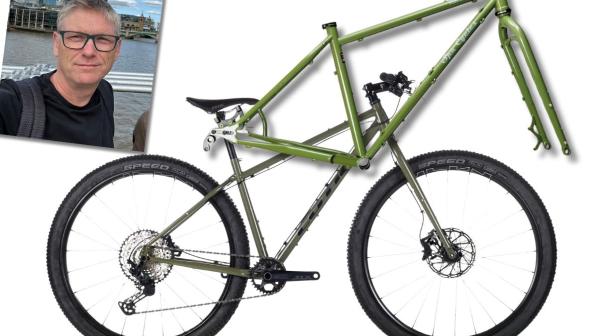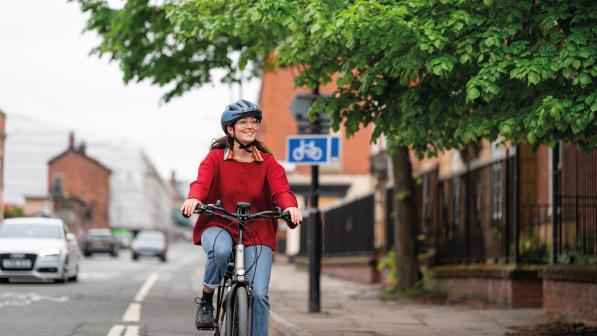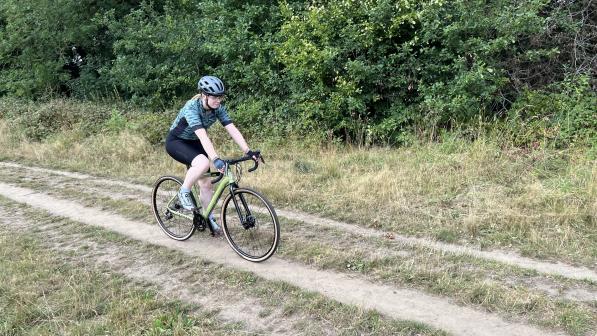Bike test: Flat-bar adventure bikes

You don’t have to own the right bike to have an adventure. But if you’re buying one for bikepacking, it’s worth considering a comfortable, luggage-friendly, flat-bar adventure bike like the two on test.
Bikepacking routes like Cycling UK’s Marcher Castles Way combine bridleways, quiet tarmac, glorious views, solitude and teashops. More than half your time will likely be off road, often on fairly good surfaces like forestry tracks, but sometimes on stony, rutted or steep trails that might cause a less confident rider to walk in places.
You can enjoy such routes on a gravel bike but my experience is that the bigger tyres, lower gears and more relaxed riding position of a mountain-style bike are ideal for most bikepacking, and will help you ride more comfortably and on more of the tricky bits.
The Rove, from Harrogate touring specialist Spa Cycles, and the Bridge Club, from independently minded US brand Surly, are both steel-framed adventure bikes. They’re like mountain bikes but with geometries that try to balance good off-road manners and all-day comfort.
They have mounts for racks, mudguards and bikepacking luggage. And instead of front suspension they have rigid forks that reflect their less technical intent.
The £1,599 Bridge Club 27.5 Whipped Butter has a lower front end and 27.5in wheels, with space for tyres up to 2.8in wide. The £1,695 Rove 725 2×10spd Deore Hydraulic has faster-rolling 29in wheels and a more upright position.
Our test bike came with a few upgrades, principally a carbon fork (£80 extra). As Spa Cycles also sent the standard steel fork, I tried it with that as well.
My first impressions were that the Bridge Club was a more practical version of a regular MTB, whereas the Rove was a faster cross between a mountain bike and a hybrid.
Frame & fork
The Rove and the Bridge Club are both made from double-butted chrome-moly steel, with an emphasis on comfort and durability. Both have a useful but not crazy amount of braze-ons: front and rear rack mounts, mudguard mounts, three pairs of bottle mounts and fork luggage mounts (angled on the Rove, parallel to the wheel on the Bridge Club).
The Rove also has mounts for a small top-tube bag, while the Bridge Club has a mount for a kickstand.
The Bridge Club was noticeably 800g heavier than the steel-forked Rove, but this was mostly down to the wheels, tubes and tyres, not the frameset. The optional carbon fork for the Rove can really seal the difference, however, saving a further kilogram and giving a smoother ride.
There are other significant differences. In terms of fit, the Rove is shorter and taller. The reach (the horizontal distance between the bottom bracket and the head tube) is 16mm less than the Bridge Club’s, while the stack (the height of the top of the head tube above the bottom bracket) is 52mm higher. It also has a higher standover height.
Both bikes come with significantly wider tyres than most gravel bikes. The Rove is based around 29er mountain bike wheels (ISO 622), except for the smallest XS size which uses 27.5in wheels (ISO 584). The Bridge Club 27.5 comes with 27.5in wheels in all sizes, as the name says, but will run 622 wheels with narrower (47mm) tyres if you prefer.
If you stick with 27.5in wheels, however, it lives up to the ‘Fatties Fit Fine’ label on the chainstays: tyres up to 2.8in wide will fit. The Rove has clearance for 2.6in tyres.
In general, the Rove has a more contemporary frameset. It takes thru-axle wheels, whereas the Bridge Club has quick-release ones.
Its 44mm head tube accommodates a tapered steerer, so you can swap in a suspension fork; the geometry is fine with a 100-120mm travel fork as the rigid fork has 490mm axle-to-crown height. The Rove also has adjustable dropouts, making it singlespeed compatible.
Components
Both bikes have sensible, practical components, and both are available with different build options.
The Bridge Club boasts Shimano’s new Cues 1×11 drivetrain, which can handle a 50-tooth low sprocket and, Shimano says, has dramatically increased durability. This version of the Rove uses Cues’ well-loved spiritual ancestor, a 2×10 Shimano Deore setup. (A Cues option on the Rove adds £180 to the price.)
But the Rove has lighter, handbuilt wheels, with folding 2.3in Teravail Ehline tyres, versus the Surly’s wire-beaded 2.4in WTB Trail Boss tyres on WTB quick-release wheels. The Bridge Club’s front wheel alone weighs nearly 400g more.
While the Tektro hydraulic brakes on the Bridge Club are fine, and better than most mechanical options, they feel like a budget choice compared with the more powerful and better-biting Deore brakes and Shimano Ice Tech rotors of the Rove.
Both bikes should winch you up almost anything. The Bridge Club’s 1× drivetrain has a lower range: 18-82in versus 21-95in for the Rove, which will be a little better suited to road speeds.
You could spec lower gears for the Rove (you’ll need to liaise with Spa and pay the difference) but the existing rear derailleur is limited to a 36-tooth large sprocket.
The test Rove came with a non-standard Brooks Cambium C17 all-weather saddle, so I can’t comment on the standard Spa Cycles one. I really liked the Cambium but some friends who tried it, male and female, found it supremely uncomfortable. The Bridge Club’s WTB Volt saddle was liked by all. Both handlebars were fine.
Ride
I enjoyed both bikes for just over two months in winter, using them for bikepacking on Marcher Castles Way and the Woods Cyclery Rat Run route, which is in Dorset and Wiltshire. I also rode them on singletrack and lanes closer to home.
The Rove really stood out for me. It felt poised, comfortable and capable. Its tyres managed to be brisk on hard surfaces and grippy on soft ones, even stiff climbs on bumpy, wet grass.
On road, its upright riding position was something of a revelation: the handlebar is more than two inches higher than the Bridge Club’s. I looked for excuses to take it on errands, and on longer local rides I admired views over hedges that I’d never seen before. The position suited all-day comfort and didn’t seem to slow me down.
Off road, it’s not as easy to commit its front wheel to a line like you would on an aggressive MTB. The steering is light, not because there’s anything unusual about the trail figure but because the front end is higher than on a normal MTB and you have less stabilising weight over the front wheel. But that contributes to its responsive feel, and you quickly get used to it on trails.
The Rove rode even better when fitted with the carbon fork upgrade. Then, at 12.5kg, it was only 600g heavier than my entry-level cross-country racing bike – although that has a suspension fork. That low weight, combined with the tyres, gave the Rove a surprising turn of acceleration.
If you want an adventure bike with more of a traditional MTB feel, the Bridge Club might be for you. You feel securely positioned ‘in’ the bike. You have a little more stabilising weight over the front wheel than on the Rove, and while the 27.5in wheels are slower rolling than the 29in hoops now found on most MTBs, they feel more playful and help give you a slightly lower centre of gravity.
On the downside, the Bridge Club’s price in sterling feels out of proportion to its dollar price, and it has a relatively basic ride for that money. It’s an all-purpose bike for town and trail, designed to take whatever abuse you throw at it and haul whatever you want.

I preferred the Bridge Club when I swapped the default 2.4in MTB tyres for some fatter, smoother-rolling 2.8in Schwalbe G-One Allround tyres. They fitted in the frame with plenty of room to spare, and running them at around 10psi gave the bike a floaty feel off road and a plush ride all round.
Both bikes were a pleasure to ride with luggage, and they both felt well balanced. I sometimes used a handlebar roll and seatpack; other times Ortlieb’s super-secure Fork Pack and Gravel Pack panniers, along with a rear Quick Rack.
The front Fork Pack panniers worked best on the Bridge Club, with its square-on fork mounts. The bar roll worked better on the Rove, as it could sit below the level of the handlebar without any risk of fouling the front tyre.
Verdict
The thing that turns any bike into an adventure bike is you. But the good news is that you plus either of these practical, assured bikes should be a recipe for many memorable trips, as well as agreeable ‘town and trail’ riding.
The Bridge Club is a solid all-rounder, but I wanted to fall in love with it more than I did. By contrast, the Rove won me over with its surprising speed, comfort, versatility and value.
If you don’t already have a mountain bike and you want to mix your bikepacking with more technical singletrack, you might prefer the Bridge Club (or perhaps a regular hardtail with front suspension). Otherwise the Rove is an easy bike to recommend as a do-everything machine or an n+1.
Other options
Kona Unit X £1,599

Good looking, Deore-equipped, bikepacking-friendly, rigid 29er from a classic steel MTB brand.
Genesis Vagabond 10 £1,799

A drop-bar adventure bike, the Vagabond uses 29×2.35in MTB tyres, Microshift Sword gearing and TRP Spyre discs.
First published in Cycle magazine, February/March 2025 issue. All information correct at time of publishing.
Cycle magazine
Every two months Cycling UK members receive Cycle magazine, filled with interesting and informative articles, news and reviews for all cyclists.
Members can read the magazine in full online; non-members can read selected highlights.




